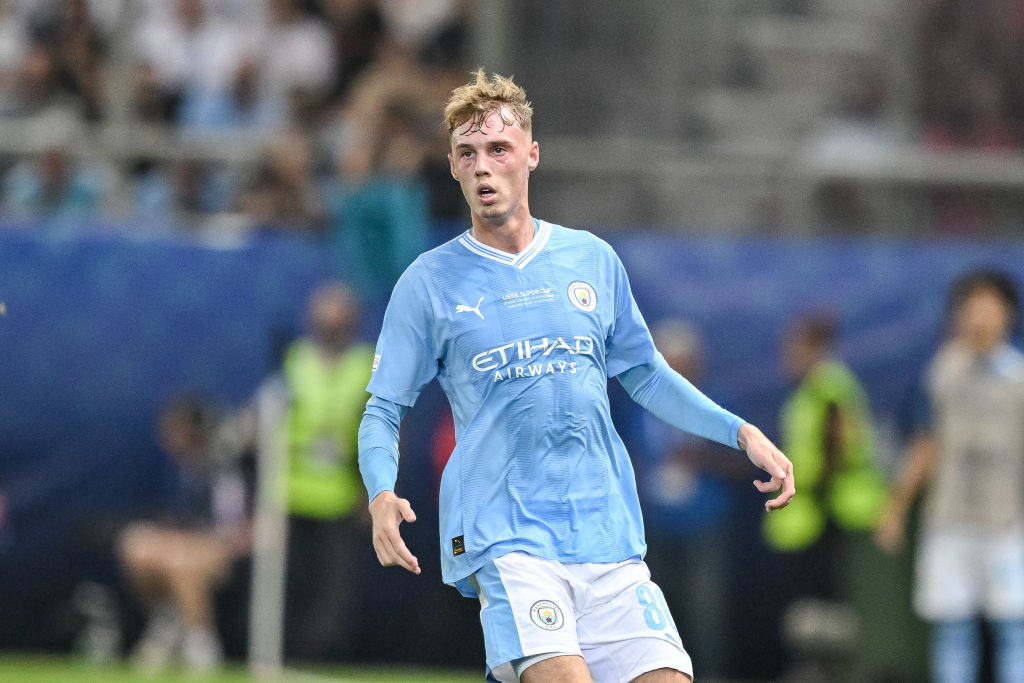Manchester United's lack of width preventing them from re-joining the elite
John Robertson explains how Louis van Gaal's men can push their dwindling goal average up and cement their hold on third place...

Historically, Manchester United have not struggled to find the back of the net. In the last five full seasons, from 2009/10 to 2013/14, only once have they failed to average fewer than two goals per league game.
Unsurprisingly, that feat came last year under David Moyes when the Salford club averaged 1.68 goals per match.
Under Louis van Gaal the goals have come more frequently, but not by much; an average of 1.72 over the 25 leagues games played so far. While that number is hardly relegation form, it's far from the glory years of Sir Alex Ferguson and far from the figure required to challenge for the title.
In the aforementioned years 2009/10 to 2013/14, the team that has gone on to win the league has always averaged more than two league goals per game. It's not beyond the realm of logic, then, to suggest that teams with title aspirations should be hitting the two-goal threshold.
This season, only Chelsea and Manchester City are currently achieving that benchmark. With the likes of Wayne Rooney, Radamel Falcao, Robin van Persie and Angel Di Maria generally included in the starting XI it's no surprise that, with respect, United are scoring goals against the likes of Leicester and Burnley. Their form against the clubs around them, however, is worrying.
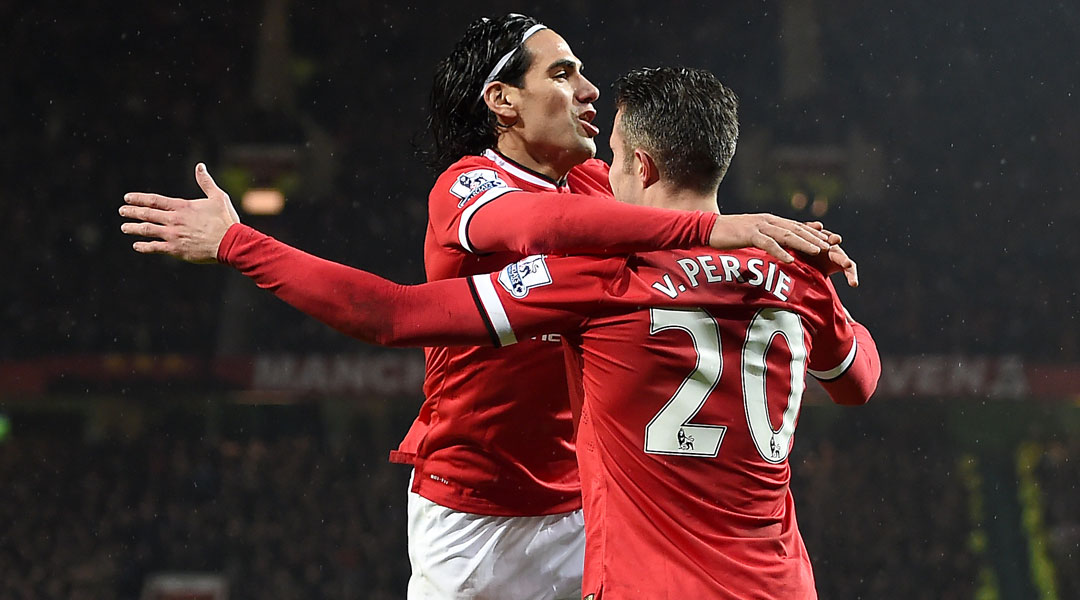
In the six games played against clubs occupying the league's top six positions, United have scored just five goals and failed to score in three of those matches. Their saving grace is that they have conceded just five.
With the race to finish in the top four being so tight, Van Gaal's side cannot afford to score similarly few goals in the four league games they have left against the top six. When also taking into account that an in-form Liverpool come before the season's end, five of their 13 remaining games are against the league's elite.
The best features, fun and footballing quizzes, straight to your inbox every week.
Shaw about Valencia?
Van Gaal's problem this season has generally been a lack of width, making it easier for top teams to organise their defences. Whether the Dutchman has set his team up in his preferred 3-5-2, or fallen back on a simple 4-4-2 with a midfield diamond, penetration down the flanks has been difficult to achieve.
No matter which formation he plays, though, it has come down to the full-backs – usually Luke Shaw and Antonio Valencia – to provide the width this season. The last game the duo started together was the 1-1 draw at Upton Park against West Ham, but their forward passing statistics accounted for just 2 successful completions apiece in dangerous wide areas. Simply, there is a lack of cohesion out wide in the attacking third.
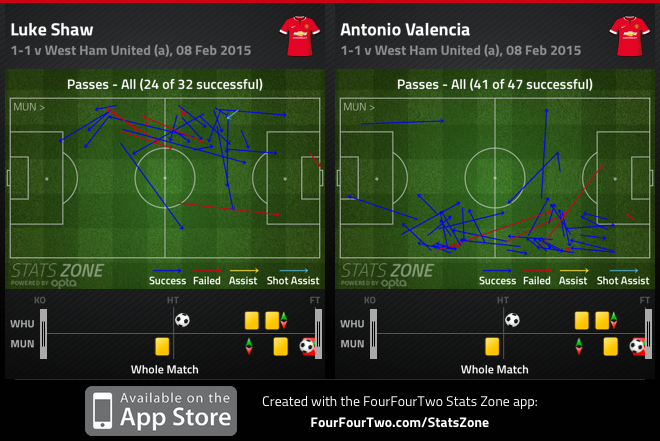
Inability to penetrate meaningfully down the flanks is further highlighted when looking at where the Red Devils created their scoring chances. Only 2 came from wide positions, and both of those limited to the left side.
The success rate of dribbles down the flanks makes for similarly depressing reading, with not a single attempt having beaten the defender. It's little wonder that Van Gaal decided to bring on Marouane Fellaini and switch to a long-ball approach late in the game to find an equaliser through Daley Blind.
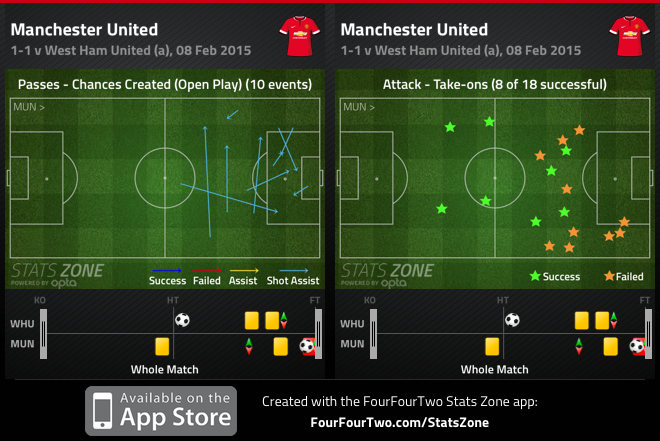
The common theme
The West Ham clash is not an isolated incident. All season, Manchester United have failed to consistently take ownership of wide areas. In games against Arsenal and Southampton earlier this campaign, only 1 chance across the two encounters was created from the wings. Even then, the position was so deep that it failed to trouble Arsenal's defence or worry goalkeeper Wojciech Szczesny.
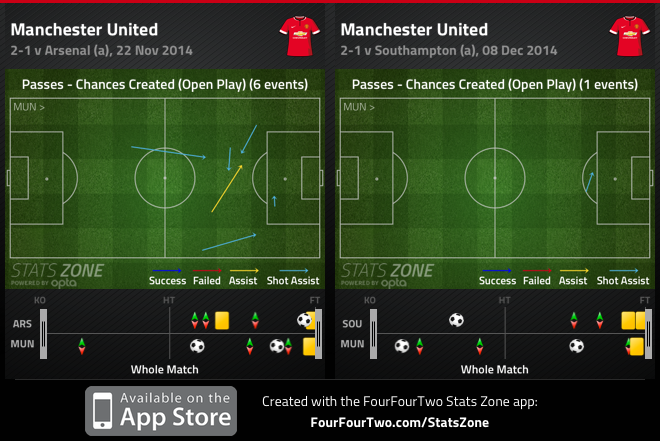
It could be argued that the lack of such chances is a moot point given United went on to collect six points from those games. But by continuing to show an inability to attack from wide, teams have figured out that they can overload the middle of the pitch and restrict scoring opportunities afforded to the Reds' frontmen.
Burnley might have fallen 3-1 at Old Trafford, but Van Gaal was open about criticising the manner of his team's performance. A look at the impact of Van Persie and Falcao makes it easy to see why he was so flustered.

By clogging up the middle of the pitch, Burnley prevented the two strikers from receiving the ball in dangerous positions. This forced them to drop ever deeper in order to get involved in the game.
Undoubtedly, as their current league position suggests, United are finding ways to win games. But they're not doing it consistently enough – particularly against their closest rivals – to give themselves breathing space in the race for Champions League football. The games highlighted against Arsenal and Southampton are the only instances in which they've managed to a beat a top six team this season.
Angel's angst
Van Gaal generally plays Di Maria through the middle to inject pace into his attack, a decision that has left many quarters confused given how devastating the Argentine was from wide positions for Real Madrid.
It seems an obvious statement, but surely United's problems would be at least partly solved by getting the ball into Di Maria's feet more often out wide. His effectiveness is highlighted by comparing where he picked up the ball in his final La Liga game for Real Madrid against the recent draw with West Ham.
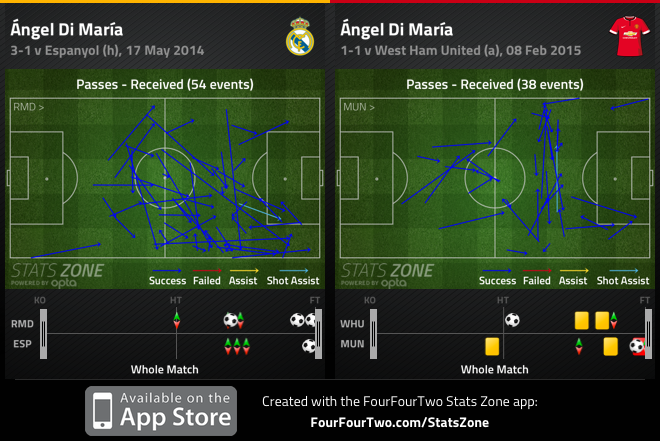
Armed with the ball in his favoured position, Di Maria against Espanyol was able to probe the box with far more dangerous passes and eventually assisted two of Real Madrid's three goals.
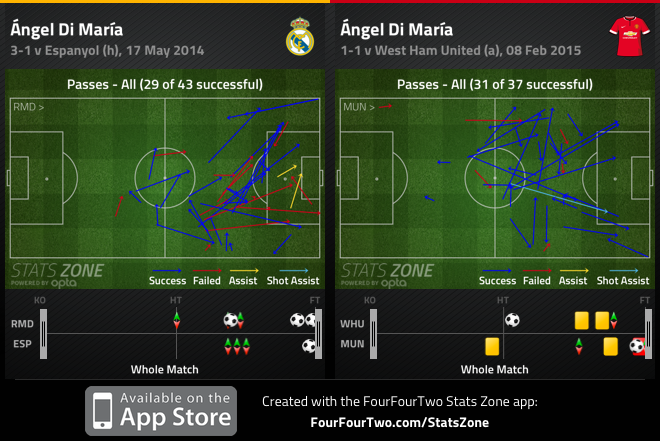
If Di Maria is able to get similarly involved under Van Gaal, it seems logical that he would be able to create at least one quality chance per game for his team-mates. If one goal every two games came as a result of that, United would be well above the magic two-per-game ratio required to challenge for the title. Numbers are rarely the most attractive lens through which to view football but, unlike so much else, they never lie.
